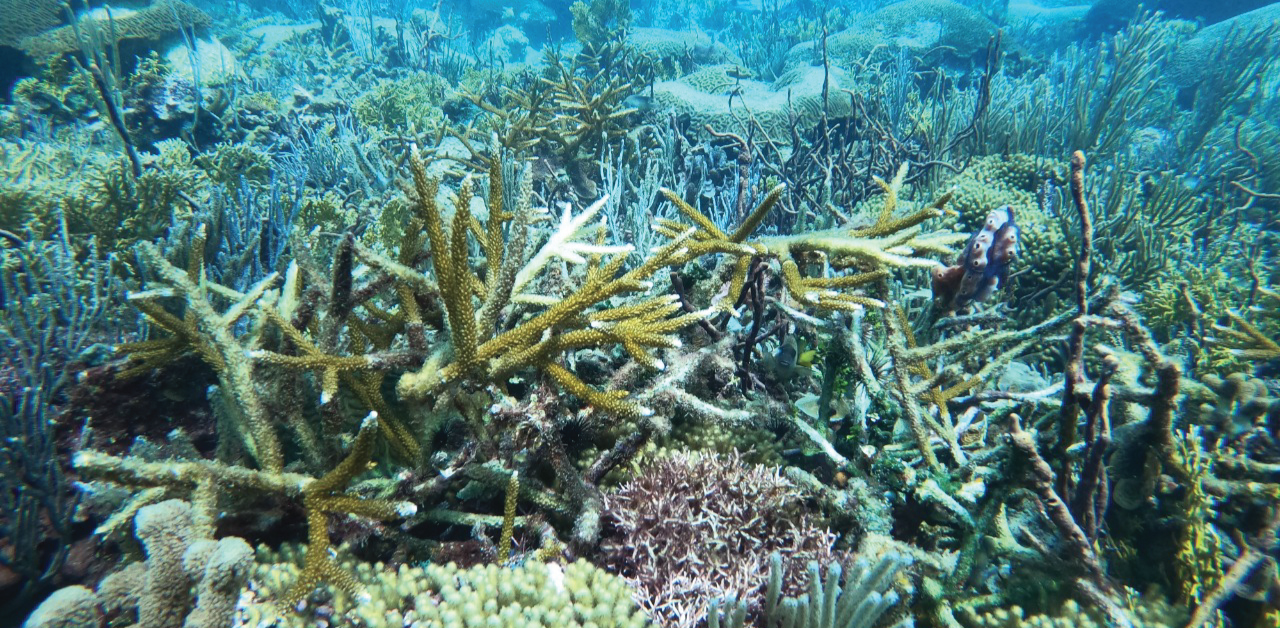What can brittle stars tell us about the response of marine species to climate warming?
A recent study conducted on coral reefs along the coast of Panama is helping to shed light on how marine species are impacted by an increasingly warming planet. The study uses unprecedented high-frequency data to examine the effects of temperature and oxygen on the species’ biological demands and habitat requirements. The results of this study have implications for the diverse marine animals that live in coral reefs and may help scientists better understand the complex dynamic between climate change and ecosystems.
Scientists have for a while now known that climatic warming has deleterious effects on marine life. One important reason is that warmer temperatures increase a species’ metabolic oxygen demand while decreasing oxygen availability. Temperature and oxygen play a central role in limiting the habitability for animal species, because together these environmental conditions determine how ‘breathable’ or ‘metabolically viable’ the water is for animals of all kinds.
“As temperatures rise, marine organisms use more energy to maintain normal life processes,” said Curtis Deutsch, a professor of geosciences and the High Meadows Environmental Institute at Princeton University and coauthor of the study. “When the ocean gets warmer, the availability of oxygen doesn’t go up, it goes down. This means that species face a much more stringent trade-off in how they use energy—they need more of it but have less of it.”
Nowhere is this more concerning than in tropical locales, which contain the largest number and greatest diversity of species on Earth, and whose warmer waters hold less oxygen than cooler, more temperate ocean waters. But the complex relationship between thermal tolerance, temperature variability and the response of many species to warming trends in tropical waters is not well understood. Most of our current understanding, Deutsch explained, has come from large-scale studies with data collected outside the tropics.
To fill the gap, Deutsch teamed up with Noelle Lucey, a marine biologist at the Smithsonian Tropical Research Institute in Panama. Lucey had been collecting high-frequency environmental data from tropical coral reefs and conducting the types of biological experiments needed to understand how animals are impacted by the variations in their environment.
The results of this collaborative study appear in this week’s issue of PLOS Climate, and they promise to untangle some of these relationships. In essence, the researchers wanted to look at how oxygen and its relationship with temperature is changing in these tropical systems, and, moreover, if these environmental changes are causing marine animals to leave their home reefs.
The research builds on more than a decade of environmental monitoring data collected by the Smithsonian Tropical Research Institute’s Physical Monitoring program and covers a portion of the Caribbean coast in Panama, called Almirante Bay. The data show a persistent difference in environment between the inner part of the bay, which is warmer and lower in oxygen, and hosts a different mix of species, relative to the outer part of the bay. Over a decade of weekly changes of water conditions can now be combined with hourly changes collected by sensors deployed by Lucey and her students.
To investigate the relationship between these environmental conditions and the distributions of reef species, Lucey conducted controlled experiments in the lab at Bocas del Toro, Panama to measure the sensitivity of species to these water properties. “These controlled experiments consisted of relatively simple and well-known assays geared toward understanding what the animal’s physiological limits are to different conditions,” Lucey said. “For instance, we’d place the animal in a beaker of sea water and increase the temperature to the point where the animal was unable to move, which we determined was the animal’s thermal limit. We also did this for oxygen.” These experiments, used for decades by marine biologists, had rarely been done on tropical species.
The researchers settled on brittle stars as an ideal case study for answering their broader questions. “Brittle stars are Echinoderms that are related to sea stars and sea urchins, and they look like long, skinny starfishes,” said Lucey. “They are common invertebrates on coral reefs, and they are both beautiful and active, making them great models to understand physiological limits to oxygen and temperature stress.”
Lucey first documented which reefs these species were living on and then with Piero Calosi and students from the Université of Québec in Rimouski, Canada, specializing in animal physiology, started to develop new tolerance and behavior assays that could be used for the brittle stars. These studies were designed to evaluate the brittle stars’ ability, for example, to sense elevated sea temperature or low oxygen and, if so, to move away from these offending conditions.
“This involved exercising these animals to measure how much energy they use in stressful environments, very much the same way a doctor can measure how fast you are breathing before and after running on a treadmill to figure out how much oxygen you need when you are active,” Lucey said.
By combining these data, the researchers were able to observe a number of trends that helped them answer a variety of questions. Chiefly, they found that it is extreme conditions, rather than the average conditions, that largely determine which parts of the reef they choose to inhabit.
They found that really stressful conditions occur not on the average but during extreme episodes. Lucey noted, for example, that for a few days, especially at night and when the brittle stars are particularly active, certain parts of the reef experience extremely low oxygen levels. If the brittle stars inhabited these areas at that time, they would not be able to be active.
“If the brittle stars just experienced these places in their average state, they would be fine,” explained Deutsch. “But they don’t, of course, experience the average; they experience every instantaneous condition that nature throws at them—and the extremely stressful conditions are frequent enough and just long enough to prevent them from living there in the long term.”
For a long time, scientists have argued that it is not the averages in nature that frequently matter most. It is, more often than not, the limiting factors at the extremes that have the greatest effect on things like reproduction, demography and habitat preference.
“Our research is one of the nicest, most holistic examples of where we can put all the pieces together—the physiological tolerance of the organisms, the high-frequency measurements, and the spatial patterns of inhabited versus uninhabited—and say ‘yes, indeed, these extreme episodes are what’s really important,’” said Lucey. “The extreme conditions are really what’s driving the pattern of where the organisms live and where they don’t live.”
The second important finding—and the one that has particular relevance for climate studies—came when the researchers began to examine the long-term data. They found that as the waters of Almirante Bay became warmer over the course of the past decade the frequency and intensity of the low oxygen conditions, a condition known as ‘hypoxia,’ has increased.
“This means that as climate gets warmer, the periods in which there is not enough oxygen for some species to breathe can become more pronounced, even if the amount of oxygen on average is not changing,” said Deutsch.
This has potentially profound implications not only for brittle stars but also for many marine species. “We also show how future warming will increase oxygen extremes and dramatically reduce habitability for even the most hypoxia-tolerant species on the reef,” Lucey said. “Low oxygen habitat exclusion might be much more widespread in the future, even if average oxygen doesn’t go down at all.”
The researchers don’t yet know if this increasing frequency of hypoxia is a widespread phenomenon, but if it is, they contend it could mean that scientists have underestimated the climate risks especially for species in the tropical oceans, where the average oxygen level is expected to be relatively stable.
Conclusions like this underscore the urgent need to understand the complex dynamics of climate change, temperature, oxygen-level fluctuation, and species biogeography.
“The oceans are getting warmer and we need to understand how that impacts its ecosystems,” said Deutsch. “The oceans have been under sampled for a long time, and major international initiatives are needed to monitor ocean health in the face of mounting challenges from climate and other human impacts.”
Other members of the research team included Marie-Hélène Carignan, Fanny Vermandele, and Piero Calosi of the Marine Ecological and Evolutionary Physiology laboratory, Département de Biologie, Chimie et Géographie, Université du Québec à Rimouski, Rimouski, Canada; Mary Collins and Rachel Collin of Smithsonian Tropical Research Institute, Balboa Ancon, Panama; and Maggie D. Johnson of the Smithsonian Tropical Research Institute and the Red Sea Research Center, King Abdullah University of Science and Technology, Thuwal, Saudi Arabia. The research was supported by the Smithsonian Tropical Research Institute, the Smithsonian Women’s Committee, Natural Sciences and Engineering Research Council of Canada Discovery Program, Canada Foundation for Innovation, and the University of Quebec in Rimouski.
The study, “Climate warming erodes tropical reef habitat through frequency and intensity of episodic hypoxia,” by Noelle M. Lucey, Curtis A. Deutsch, Marie-Hélène Carignan, Fanny Vermandele, Mary Collins, Maggie D. Johnson, Rachel Collin, and Piero Calosi was published online in the journal PLOS Climate on March. 1, 2023.
Article link: https://journals.plos.org/climate/article?id=10.1371/journal.pclm.0000095




